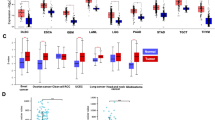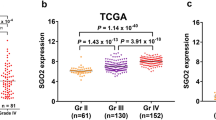Abstract
Malignant glioma is the most common brain tumor with 16 000 new cases diagnosed annually in the United States. We performed a systematic large-scale transcriptomics data mining study of 9783 tissue samples from the GeneSapiens database to systematically identify genes that are most glioma-specific. We searched for genes that were highly expressed in 322 glioblastoma multiforme tissue samples and 66 anaplastic astrocytomas as compared with 425 samples from histologically normal central nervous system. Transcription cofactor HES6 (hairy and enhancer of split 6) emerged as the most glioma-specific gene. Immunostaining of a tissue microarray showed HES6 expression in 335 (98.8%) out of the 339 glioma samples. HES6 was expressed in endothelial cells of the normal brain and glioma tissue. Recurrent grade 2 astrocytomas and grade 2 or 3 oligodendrogliomas showed higher levels of HES6 immunoreactivity than the corresponding primary tumors. High HES6 mRNA expression correlated with the proneural subtype that generally has a favorable outcome but is prone to recur. Functional studies suggested an important role for HES6 in supporting survival of glioma cells, as evidenced by reduction of cancer cell proliferation and migration after HES6 silencing. The biological role and consequences of HES6 silencing and overexpression was explored with genome-wide analyses, which implicated a role for HES6 in p53, c-myc and nuclear factor-κB transcriptional networks. We conclude that HES6 is important for glioma cell proliferation and migration, and may have a role in angiogenesis.
This is a preview of subscription content, access via your institution
Access options
Subscribe to this journal
Receive 50 print issues and online access
$259.00 per year
only $5.18 per issue
Buy this article
- Purchase on Springer Link
- Instant access to full article PDF
Prices may be subject to local taxes which are calculated during checkout






Similar content being viewed by others
Accession codes
References
Bae S, Bessho Y, Hojo M, Kageyama R . (2000). The bHLH gene Hes6, an inhibitor of Hes1, promotes neuronal differentiation. Development 127: 2933–2943.
Cancer Genome Atlas Research Network (2008). Comprehensive genomic characterization defines human glioblastoma genes and core pathways. Nature 455: 1061–1068.
Cooper LA, Gutman DA, Long Q, Johnson BA, Cholleti SR, Kurc T et al. (2010). The proneural molecular signature is enriched in oligodendrogliomas and predicts improved survival among diffuse gliomas. PLoS One 5: e12548.
Cossins J, Vernon AE, Zhang Y, Philpott A, Jones PH . (2002). Hes6 regulates myogenic differentiation. Development 129: 2195–2207.
Eun B, Cho B, Moon Y, Kim SY, Kim K, Kim H et al. (2010). Induction of neuronal apoptosis by expression of Hes6 via p53-dependent pathway. Brain Res 1313: 1–8.
Eun B, Lee Y, Hong S, Kim J, Lee HW, Kim K et al. (2008). Hes6 controls cell proliferation via interaction with cAMP-response element-binding protein-binding protein in the promyelocytic leukemia nuclear body. J Biol Chem 283: 5939–5949.
Gratton MO, Torban E, Jasmin SB, Theriault FM, German MS, Stifani S . (2003). Hes6 promotes cortical neurogenesis and inhibits Hes1 transcription repression activity by multiple mechanisms. Mol Cell Biol 23: 6922–6935.
Haapasalo JA, Nordfors KM, Hilvo M, Rantala IJ, Soini Y, Parkkila AK et al. (2006). Expression of carbonic anhydrase IX in astrocytic tumors predicts poor prognosis. Clin Cancer Res 12: 473–477.
Hartman J, Lam EW, Gustafsson JA, Strom A . (2009). Hes-6, an inhibitor of hes-1, is regulated by 17beta-estradiol and promotes breast cancer cell proliferation. Breast Cancer Res 11: R79.
Hong F, Breitling R, McEntee CW, Wittner BS, Nemhauser JL, Chory J . (2006). RankProd: A bioconductor package for detecting differentially expressed genes in meta-analysis. Bioinformatics 22: 2825–2827.
Illi B, Puri P, Morgante L, Capogrossi MC, Gaetano C . (2000). Nuclear factor-kappaB and cAMP response element binding protein mediate opposite transcriptional effects on the flk-1/KDR gene promoter. Circ Res 86: E110–E117.
Jennings BH, Tyler DM, Bray SJ . (1999). Target specificities of drosophila enhancer of split basic helix-loop-helix proteins. Mol Cell Biol 19: 4600–4610.
Jhas S, Ciura S, Belanger-Jasmin S, Dong Z, Llamosas E, Theriault FM et al. (2006). Hes6 inhibits astrocyte differentiation and promotes neurogenesis through different mechanisms. J Neurosci 26: 11061–11071.
Joensuu H, Puputti M, Sihto H, Tynninen O, Nupponen NN . (2005). Amplification of genes encoding KIT, PDGFRalpha and VEGFR2 receptor tyrosine kinases is frequent in glioblastoma multiforme. J Pathol 207: 224–231.
Kilpinen S, Autio R, Ojala K, Iljin K, Bucher E, Sara H et al. (2008). Systematic bioinformatic analysis of expression levels of 17 330 human genes across 9 783 samples from 175 types of healthy and pathological tissues. Genome Biol 9: R139.
Koyano-Nakagawa N, Kim J, Anderson D, Kintner C . (2000). Hes6 acts in a positive feedback loop with the neurogenins to promote neuronal differentiation. Development 127: 4203–4216.
Kumar HR, Zhong X, Sandoval JA, Hickey RJ, Malkas LH . (2008). Applications of emerging molecular technologies in glioblastoma multiforme. Expert Rev Neurother 8: 1497–1506.
Lassman AB, Dai C, Fuller GN, Vickers AJ, Holland EC . (2004). Overexpression of c-MYC promotes an undifferentiated phenotype in cultured astrocytes and allows elevated ras and akt signaling to induce gliomas from GFAP-expressing cells in mice. Neuron Glia Biol 1: 157–163.
Madhavan S, Zenklusen JC, Kotliarov Y, Sahni H, Fine HA, Buetow K . (2009). Rembrandt: Helping personalized medicine become a reality through integrative translational research. Mol Cancer Res 7: 157–167.
Margolin AA, Palomero T, Sumazin P, Califano A, Ferrando AA, Stolovitzky G . (2009). ChIP-on-chip significance analysis reveals large-scale binding and regulation by human transcription factor oncogenes. Proc Natl Acad Sci U S A 106: 244–249.
Mpindi JP, Sara H, Haapa-Paananen S, Kilpinen S, Pisto T, Bucher E et al. (2011). GTI: A novel algorithm for identifying outlier gene expression profiles from integrated microarray datasets. PLoS One 6: e17259.
Naumann U, Maass P, Gleske AK, Aulwurm S, Weller M, Eisele G . (2008). Glioma gene therapy with soluble transforming growth factor-beta receptors II and III. Int J Oncol 33: 759–765.
Noushmehr H, Weisenberger DJ, Diefes K, Phillips HS, Pujara K, Berman BP et al. (2010). Identification of a CpG island methylator phenotype that defines a distinct subgroup of glioma. Cancer Cell 17: 510–522.
Ohgaki H, Kleihues P . (2009). Genetic alterations and signaling pathways in the evolution of gliomas. Cancer Sci 100: 2235–2241.
Ohgaki H, Kleihues P . (2007). Genetic pathways to primary and secondary glioblastoma. Am J Pathol 170: 1445–1453.
Ovaska K, Laakso M, Haapa-Paananen S, Louhimo R, Chen P, Aittomaki V et al. (2010). Large-scale data integration framework provides a comprehensive view on glioblastoma multiforme. Genome Med 2: 65.
Panicker SP, Raychaudhuri B, Sharma P, Tipps R, Mazumdar T, Mal AK et al. (2010). p300- and myc-mediated regulation of glioblastoma multiforme cell differentiation. Oncotarget 1: 289–303.
Puputti M, Tynninen O, Sihto H, Blom T, Maenpaa H, Isola J et al. (2006). Amplification of KIT, PDGFRA, VEGFR2, and EGFR in gliomas. Mol Cancer Res 4: 927–934.
Schiffer D, Annovazzi L, Caldera V, Mellai M . (2010). On the origin and growth of gliomas. Anticancer Res 30: 1977–1998.
Sihto H, Tynninen O, Halonen M, Puputti M, Karjalainen-Lindsberg ML, Kukko H et al. (2009). Tumour microvessel endothelial cell KIT and stem cell factor expression in human solid tumours. Histopathology 55: 544–553.
Somasundaram K, Reddy SP, Vinnakota K, Britto R, Subbarayan M, Nambiar S et al. (2005). Upregulation of ASCL1 and inhibition of notch signaling pathway characterize progressive astrocytoma. Oncogene 24: 7073–7083.
Strojnik T, Rosland GV, Sakariassen PO, Kavalar R, Lah T . (2007). Neural stem cell markers, nestin and musashi proteins, in the progression of human glioma: Correlation of nestin with prognosis of patient survival. Surg Neurol 68: 133–143.
Swearingen ML, Sun D, Bourner M, Weinstein EJ . (2003). Detection of differentially expressed HES-6 gene in metastatic colon carcinoma by combination of suppression subtractive hybridization and cDNA library array. Cancer Lett 198: 229–239.
Verhaak RG, Hoadley KA, Purdom E, Wang V, Qi Y, Wilkerson MD et al. (2010). Integrated genomic analysis identifies clinically relevant subtypes of glioblastoma characterized by abnormalities in PDGFRA, IDH1, EGFR, and NF1. Cancer Cell 17: 98–110.
Vias M, Massie CE, East P, Scott H, Warren A, Zhou Z et al. (2008). Pro-neural transcription factors as cancer markers. BMC Med Genomics 1: 17.
Wang GK, Hu L, Fuller GN, Zhang W . (2006). An interaction between insulin-like growth factor-binding protein 2 (IGFBP2) and integrin alpha5 is essential for IGFBP2-induced cell mobility. J Biol Chem 281: 14085–14091.
Watson PA, Vinson C, Nesterova A, Reusch JE . (2002). Content and activity of cAMP response element-binding protein regulate platelet-derived growth factor receptor-alpha content in vascular smooth muscles. Endocrinology 143: 2922–2929.
Wesolowska A, Kwiatkowska A, Slomnicki L, Dembinski M, Master A, Sliwa M et al. (2008). Microglia-derived TGF-beta as an important regulator of glioblastoma invasion--an inhibition of TGF-beta-dependent effects by shRNA against human TGF-beta type II receptor. Oncogene 27: 918–930.
Wu J, Vallenius T, Ovaska K, Westermarck J, Makela TP, Hautaniemi S . (2009). Integrated network analysis platform for protein-protein interactions. Nat Methods 6: 75–77.
Acknowledgements
This work was supported by the Academy of Finland Translational Genome-Scale Biology Center of Excellence, the Sigrid Juselius foundation and EU-FP6 project RIGHT (LSHB-CT-2004-005276). We acknowledge Dr Bokkee Eun for the generous gift of the HES6 overexpression plasmid pEYFP-C1-Hes6 (Eun et al., 2008). We also acknowledge the Finnish DNA Microarray Centre for their excellent technical assistance.
Author information
Authors and Affiliations
Corresponding author
Ethics declarations
Competing interests
The authors declare no conflict of interest.
Additional information
Supplementary Information accompanies the paper on the Oncogene website
Supplementary information
Rights and permissions
About this article
Cite this article
Haapa-Paananen, S., Kiviluoto, S., Waltari, M. et al. HES6 gene is selectively overexpressed in glioma and represents an important transcriptional regulator of glioma proliferation. Oncogene 31, 1299–1310 (2012). https://doi.org/10.1038/onc.2011.316
Received:
Revised:
Accepted:
Published:
Issue Date:
DOI: https://doi.org/10.1038/onc.2011.316
Keywords
This article is cited by
-
Tracing the origins of glioblastoma by investigating the role of gliogenic and related neurogenic genes/signaling pathways in GBM development: a systematic review
World Journal of Surgical Oncology (2022)
-
Single-cell RNA sequencing reveals intratumoral heterogeneity in primary uveal melanomas and identifies HES6 as a driver of the metastatic disease
Cell Death & Differentiation (2021)
-
Hairy and Enhancer of Split 6 (Hes6) Deficiency in Mouse Impairs Neuroblast Differentiation in Dentate Gyrus Without Affecting Cell Proliferation and Integration into Mature Neurons
Cellular and Molecular Neurobiology (2016)
-
Loss of Diacylglycerol Kinase-Ζ Inhibits Cell Proliferation and Survival in Human Gliomas
Molecular Neurobiology (2016)
-
Mitofusin-2 over-expresses and leads to dysregulation of cell cycle and cell invasion in lung adenocarcinoma
Medical Oncology (2015)



